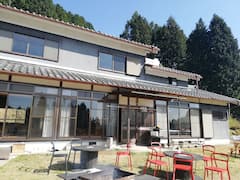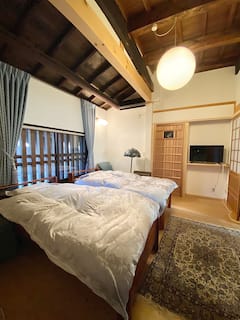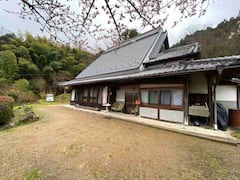No trip to Nara is complete without seeing Todaiji Temple and one of its most important halls, Nigatsu-do. Tucked somewhat far away from the main tourism area, the beautiful Nigatsu-do rises quietly and majestically. Built into the mountainside, this building is a great place to get an amazing view of Nara Basin, the birthplace of Tempyo Period (729-749AD) culture. That means it has 1300 years of history! Read on to learn everything you need to know about Nigatsu-do.
White Stone Walls and Cobblestone Paths Lead to the Temple

Nigatsu-do is one of the halls of Todaiji Temple, which was designated a World Cultural Heritage site. To the right of the main Todaiji hall, which houses the famous Nara Daibutsu (giant Buddha statue), a path runs alongside a stream. To find Nigatsu-do, take this path straight, then take a right at the T-junction.
In the picture above, Nigatsu-do is the building in the center with the triangular roof. The spacious cobblestone paths and stone and white walls on the path there create an ancient feeling atmosphere. In spring, heart warming cherry blossoms and plum flowers can be seen hanging over the wall. The foliage in the fall is spectacular and contrasts well against the white walls. Take a stroll and get a feel for what it would be like to have lived in ancient Nara.
Built Into the Mountainside, Nigatsu-do was Built Using Many Artisan Techniques

This picture was taken looking up at Nigatsu-do, which is built into the mountain’s western face. Its most unique characteristic is how it was built to be jutting out. This “hanging” style of temple construction is called kaketsukuri in Japanese. Pillars underneath have been adjusted to support the structure and ensure that the floor is level.
There are stairs on both sides of Nigatsu-do, with an unusual pattern on the face of the stone stairs on the south side. Stepping on the stairs, which have arabesque designs, turtles, flowing water, and waves carved into them, is said to bring good health. In front of the hall is a tree called roben sugi (towards the left side of the picture), a giant Japanese cedar tree. Legend has it that during the Nara Period (710-794AD), a to-be priest named Roben, who was still a baby at the time, was one day swept away by an eagle and left in the cedar. He went on to become an excellent priest, and it was made great efforts in the construction of Todaiji temple.
The Persistent Spirit of the Majestic Nigatsu-do

Nigatsu-do isn’t a particularly large hall, but it has a tranquil personality and an air of dignity which lets you feel the profundity on Nara. It’s also famous as the place where the spring tradition of drawing sacred water called Omizu-tori, formally known as Shunie, is performed. The original hall was destroyed in an accidental fire that occurred during Omizu-tori. The current iteration of the building was reconstructed in 1669 (with assistance from Edo Shogun Ietsuna Tokugawa). It has been designated as a National Treasure of Japan. Omizu-tori has been held without interruption since the 8th century. It is said to help in overcoming all kinds of crises and hardships. This spirit of persistence is impressed upon visitors by the appearance of Nigatsu-do.
You might be interested in these Airbnbs!
The Corridors Surrounded by Tsuridoro, and Kannon

Tsuridoro (traditional hanging lamps) can be seen surrounding the open corridors of Nigatsu-do. The lanterns are lit at sunset and give a fantastic appearance to their surroundings. Their dignified presence will make you feel as if you’ve gone back in time. The right side of the picture is the hall’s facade. Here you’ll find a statue of Kannon, the Buddhist Goddess of Mercy, who is said to be filled with “warmth like that of human skin.”
In Japanese Buddhism, it’s said that Roben’s disciple Jicchu was on the beach is Osaka. There, he offered a flower as sacrifice, and Kannon appeared from the ocean. Now, prayers are offered up to Kannon during the Shunie ritual that has been held consistently for 1200 years.
Perfect Place to Gaze Upon Nara Basin

The picture above is the view from Nigatsu-do. The structure in the top right is one of the cloisters of the hall, and the large roof to the right that is visible through the trees is Todaiji Temple’s Daibutsuden (temple which houses a large Buddha statue). At sunset, the ornamental roof tiles of the Daibutsuden are bathed in sunlight and glow a golden color, while the roofs of the buildings below turn red. The Nara Basin spreads far and wide as the sun sinks behind the Ikomayama mountain in the distance.
Seeing as it’s built into the mountainside, Nigatsu-do is situated at quite a high location for Nara, and the view really does rival that of Tokyo’s Sky Tree. Past Ikomayama, where the sun will set and the sky will darken, lies the very spot on the beach where Kannon is said to have first appeared to the followers of Nigatsu-do. Perhaps you’ll even see all the way to Budaraku, the mountain where Kannon is said to dwell. Be sure to include Nigatsu-do in your Nara itinerary.
Todaiji Temple - Nigatsu-do
- Address: Zoshicho 406-1, Nara City, Nara Prefecture
- TEL: 0742-22-3386 (+81 742-22-3386 from outside Japan)
- Access: 30 minutes walk or 4 minute bus ride from Kinki Nippon Tetsudo (Kintetsu) Nara Line’s Kintetsu Nara Station.
- Entry: Free of Charge
Secret Buddhas
There are various sizes of buddha statues at Nigatsu-do, but some are hibutsu, (Buddhas not on public display). Even priests who are learning the Shunie ritual are prohibited from viewing these. However, Nigatsu-do is accessible 24 hours a day, so feel free to visit any time. Kannon will be waiting with her warmth and graciousness.
History
Get Trip101 in your inbox
Unsubscribe in one click. See our Privacy Policy for more information on how we use your data




















Create an account to